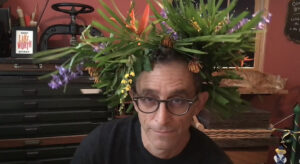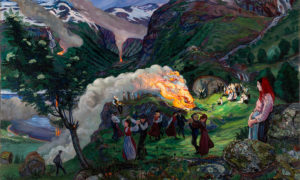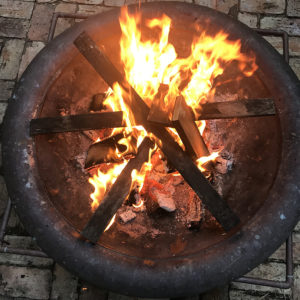A midsummer gift for you, and an invitation to join us on Saturday at Lake Worth’s Island Fest.
And so the wheel of the year moves forward one more notch: 5:13 AM Eastern on the 21st of June brings the Summer Solstice to the Northern Hemisphere. It is the astronomical start of summer, and, by traditional reckoning of time, midsummer, for now, after six months of increasing daylight and of the sun climbing higher and higher in the northern sky, things will seem to stand still for a day or two (this is the origin of the word solstice) and then, practically imperceptibly at first, things will shift the other way, and daylight will begin to diminish. This is the constant back and forth, the constant give and take, the constant rearrange that is the result of our planet on its tilted axis orbiting the sun: the tilt gives us our seasons, and the rhythm of our lives in tune with the natural world.
To the solstices the Church assigned great entrances into the world: To the solstice of midwinter it assigned the birth of Christ, and to the solstice of midsummer, the birth of his cousin, John the Baptist. Hence, Christmas falls just after the December solstice, and on this side of the wheel of the year, St. John’s Day falls just after the June solstice, on the 24th. And just as Christmas Eve is considered a magical time (animals speaking at midnight, animals kneeling to pray, wells running with wine), so is St. John’s Eve considered a magical time, as well. And while some people will insist that William Shakespeare’s “A Midsummer Night’s Dream” is set on May Eve (April 30, Walpurgis Night), I don’t think that’s quite right. I subscribe to the camp that believes the play is set on St. John’s Eve, the 23rd of June.
This is precisely why I read an adaptation of “A Midsummer Night’s Dream” for a new video series from the Jaffe Center for Book Arts. It’s called Stay Awake Bedtime Stories. The episode was just released, in time for St. John’s Eve this Thursday night and St. John’s Day on Friday, but also in time for the solstice. Seth made the floral crown for me, and Haden the Convivio Shopcat is there at the start of the video (though she soon stretched and ventured off in search of a meal). The reading is my gift to you at this magical time of year. Please enjoy it by clicking here.
This is the second story I’ve read for the series, but I began Stay Awake with the idea of enlisting storytelling help from friends of mine around the globe. “A Midsummer Night’s Dream” is only Episode No. 4. Aside from me reading that, you can Stay Awake with me as I read “Pierre” by Maurice Sendak. But also Stay Awake with British artist Davy McGuire as he reads “That Pesky Rat” by Lauren Child, and Stay Awake with master storyteller Jonathan Kruk as he performs “The Misadventures of Ichabod Crane.” Find all four episodes here at the Stay Awake tab at jaffecollection.org. And if you follow the project on Instagram (@stayawakebedtimestories), you’ll be amongst the very first to know about new episodes, for our followers there typically learn about new broadcasts days before anyone else. (You’ll find Convivio Bookworks there, too: @conviviobookworks.)
COME SEE US!
We’ll be at Lake Worth’s inaugural Island Festival this Saturday from 3 to 9.
It’s our first pop-up market since Eastertime and I’m really excited for the stilt walkers and the Junkanoo band and the Polynesian fire dancers. Island Fest is a free event for the whole family and it’s at Hatch 1121, just west of City Hall at 1121 Lucerne Avenue here in Lake Worth (the same place where we gather each year for our local Dia de Los Muertos celebration). Hopefully the weather stays dry! We’ll be there with all our textiles (including Millie’s Tea Towels) and some of our traditional artisan goods from Mexico, some things for Midsummer from Germany and Sweden, and our Shaker herbs and teas and soaps. Click here for full details and if you come by, please say hello!
Finally, I apologize for not writing more. Things have been way too busy at work. You know I would have written if I could have for all the celebrations I’ve missed: Juneteenth, Father’s Day, Bloomsday, Pentecost… but I’ll do my best to be with you for the celebrations to come. In the meantime: Give me your hands if we be friends. Happy Midsummer to you.


